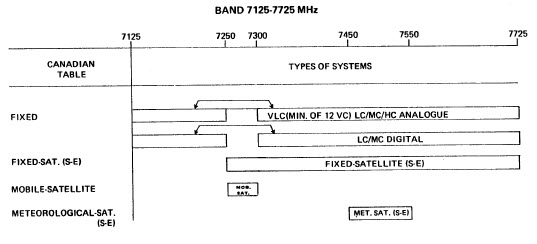Effective Date: December 1982
Table of Contents
Telecommunications Policy Branch
Spectrum and Orbit Policy Directorate
1. Intent
The purpose of this document is to specify the spectrum usage policy for the 7125–7725 MHz band by the Fixed Service.
2. Introduction
The policy in this document culminates from a three phase public consultation process which commenced in 1979 with the release of a discussion paper followed by a second paper containing proposals in July, 1981, both of which were published in the Canada Gazette.
In response to the public submissions received on these papers and the need to relieve spectrum congestion, the Department adopted new licensing policies for microwave radio in the 1–10 GHz frequency range. This document contains extracts from the final document entitled "Policy for the Utilization of the 0.890–10.68 GHz Radio Spectrum by the Fixed Service" which was notified in the Canada Gazette December 11, 1982.
3. Policy
3.1 Types of Fixed Systems Permitted in the Band
Services allocated in the 7125–7725 MHz band, in accordance with the Canadian Table of Frequency Allocations are shown in Table 1.
In the fixed service, VLC (min. of 12 VC)/LC/MC/HC analogue systems and LC/MC digital systems are the standard use.
After the 7125–7725 MHz band was re-channelled in 1977, it came into wide use for microwave systems associated with the telemetry, control and protection of electric power grids. Grids exist on a regional basis, requiring for their support a microwave network of comparable extent and high reliability. Although traffic volumes for this usage are moderate, the microwave network must be capable of expansion in rough geographic conformance to the power grid, which may in time become national in scope. In continuing and strengthening this past practice, assignments in the 7125–7725 MHz band will therefore be made primarily but not exclusively to systems serving the telemetry, control and protection purpose. Applicants with such primary uses are encouraged to file their system plans with the Department and to update these plans on a regular basis, so that applications for other uses can be coordinated with these primary systems in accordance with Radio Standards Procedure 113.
3.2 Sharing Aspects with Other Services
The fixed service shares portions of this band equally on a primary basis with the fixed-satellite, and meteorological-satellite services. The mobile satellite and fixed-satellite services share the 7250–7300 MHz allocation.
Use of the fixed-satellite and mobile-satellite services in this band is restricted to the Government of Canada. Coordination is required between the fixed terrestrial services and satellite services.
3.3 Specific Arrangement for Non-Standard Systems
In 1977, radio licensing policies were issued in which the 7125–7725 MHz and 7725–8275 MHz bands were re-channelled primarily but not exclusively to satisfy the respective service applications of the power utilities and the telecommunication common carriers. In so doing, it was recognized that existing systems which became non-standard because of these policies should be protected to the extent possible. Protection from modification or replacement for existing non-standard systems was therefore granted until at least 1 January 1984 with provision to continue operation after that date unless the entry or expansion of a standard system was blocked. In addition, new non-standard systems would be considered for licensing under exceptional circumstances and given the same protection as existing non-standard systems. These arrangements are reflected in SRSP's 305/306, issue 2, sections 2.4 and 2.6 with the further remark that the date for ending protection against the eventuality of modification or replacement would be determined for each Region of the Department. These Regional dates (not to precede 1 January 1984) have now been established as follows:
| Atlantic Region | 1 January 1985 |
|---|---|
| Quebec Region | 1 January 1985 |
| Ontario Region | 1 January 1985 |
| Central Region | 1 January 1985 |
| Pacific Region | 1 January 1984 |
Radio Systems in the 7125–7725 MHz and 7725–8275 MHz bands that are non-conforming to issue 2 of SRSP's 305 and 306 respectively will be subject to modification or replacement on the dates shown above for each Region if they come into conflict with standard systems, rather than five years after the 1977 date of issue 2. Except in this respect, the general arrangement for non-standard systems (SP-GEN) applies equally to the 7125–7725/7725–8275 MHz bands.
4.0 Additional Information
4.1 Related Documents
The following documents are applicable:
- Spectrum Utilization Policy in the Frequency Range 0.890–10.68 GHz by the Fixed Service, December 1982
- Radio Standards Procedures (RSP-113) — Application Procedures for Planned Radio Stations Above 890 MHz in the Fixed Service
| S-E | Space-to-Earth |
|---|---|
| VLC | Very Low Capacity |
| LC | Low Capacity |
| MC | Medium Capacity |
| HC | High Capacity |
| VC | Voice Channels |
Remarks
- (a) Frequency diversity continues to be standard subject to the conditions specified in SRSP 305, issue 2 and the associated Statement of Interpretation dated 7 November 1978.
(b) Two-frequency plans continue to be standard with exceptions as specified in SRSP 305, issue 2 and the associated Statement of Interpretation dated 7 November 1978. - The carriage of TV signals is non-standard in this band.
- Use of the fixed-satellite and mobile-satellite services in this band is reserved for the Government of Canada. Co-ordination is required.
- Assignments in this band will be made primarily but not exclusively to systems serving the telemetry, control and protection purpose.

